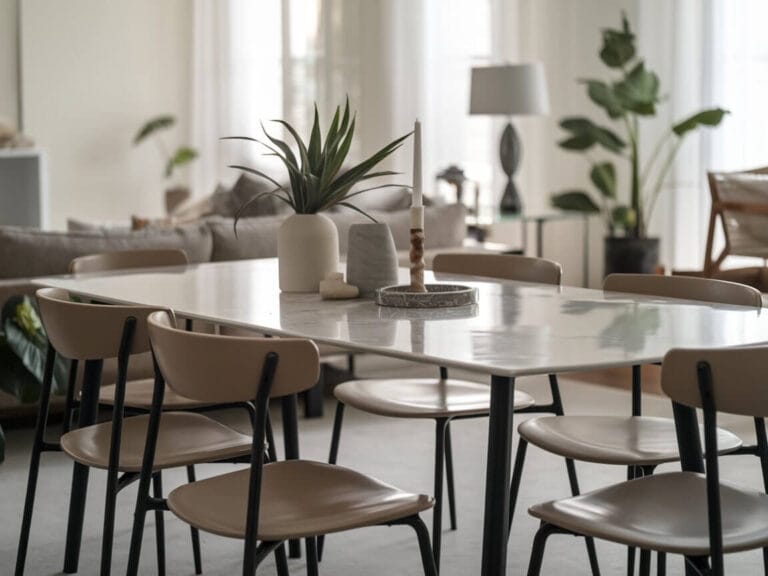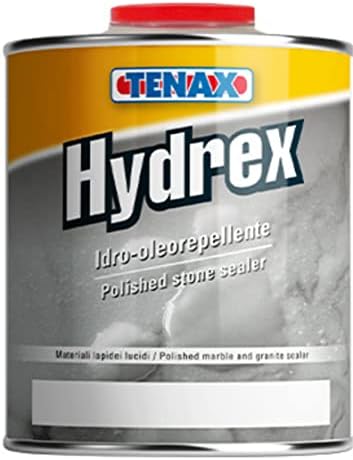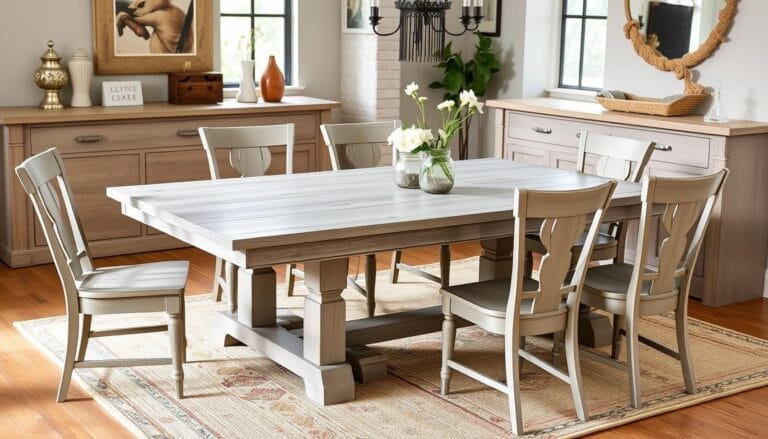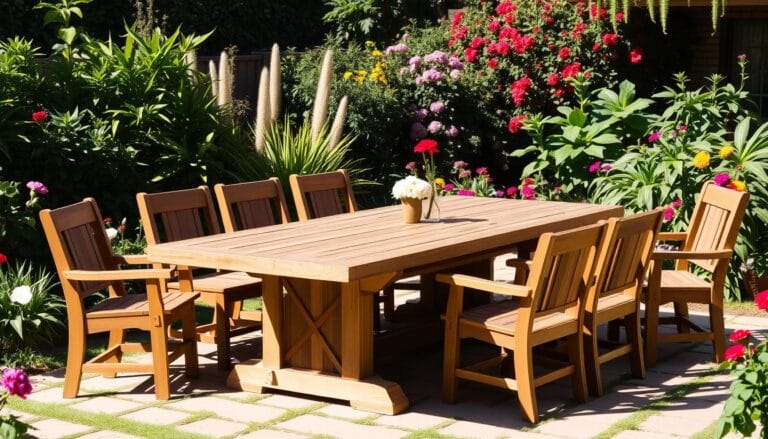Care for marble table surfaces requires dedication, knowledge, and the right approach to preserve their natural beauty and elegance. Understanding proper marble care techniques will help you maintain your investment and enjoy your stunning table for decades to come.
Table of Contents
1. Understanding Your Marble Table
1.1. Types of marble and their characteristics
Marble tables come in various types, each with its own unique beauty. I remember when I first got my Carrara marble table – I was amazed by its delicate gray veining on a white background. Other popular types include:
- Calacatta: Known for its dramatic veining
- Emperador: Comes in rich brown tones
- Statuario: Features bold, elegant veins
Each type has different levels of hardness and porosity, which affects how you should care for them.
1.2. Recognizing the unique properties of your marble
Marble is a natural stone, so each piece is one-of-a-kind. My table has a few tiny pits and swirls that make it special. Here’s what to look for in your marble:
- Color variations
- Veining patterns
- Natural imperfections
These characteristics make your table unique and shouldn’t be seen as flaws.
1.3. Assessing your table’s finish (polished, honed, or antiqued)
The finish of your marble table affects its care routine. My table has a polished finish, which gives it a glossy look but makes it more prone to showing etches. Here’s a quick guide:
- Polished: Smooth and shiny
- Honed: Matte appearance, less slippery
- Antiqued: Textured surface with a worn look
Knowing your table’s finish helps you choose the right care products and methods.
2. Daily Care for Marble Table Maintenance
2.1. Choosing the right cleaning products
When it comes to cleaning my marble table, I’ve learned that less is more. Stick to mild, pH-neutral cleaners. I use a solution of warm water and a few drops of dish soap. Avoid acidic or abrasive cleaners – they can damage the marble.
2.2. Proper wiping and drying methods
I always use a soft, lint-free cloth for cleaning. Here’s my routine:
- Dampen the cloth with the cleaning solution
- Wipe the table gently in a circular motion
- Rinse the cloth with clean water and wipe again to remove soap residue
- Dry immediately with a soft towel to prevent water spots
2.3. Dealing with spills immediately
Quick action is key when it comes to spills. I once knocked over a glass of red wine and panicked, but by acting fast, I avoided a stain. Here’s what to do:
- Blot the spill with a clean, dry cloth (don’t wipe, as it can spread the spill)
- Rinse the area with clean water
- Dry thoroughly
For stubborn spills, a poultice might be necessary (more on that later).
2.4 Essential Tools and Products for Daily Care
Over the years of caring for my marble table, I’ve discovered that having the right tools and products makes all the difference between a quick, effective cleaning routine and a frustrating experience that might even damage your beautiful marble surface.
Your Marble Care Essential Kit
Think of this as your marble table’s first aid kit – these are the items I keep within easy reach and use regularly:
For Daily Cleaning: The foundation of good marble care starts with gentle, appropriate cleaning products. I’ve learned the hard way that not all “natural stone cleaners” are created equal. After trying numerous products, I’ve found that pH-neutral cleaners specifically formulated for marble give the best results without risking etching or dulling the surface. Look for cleaners that explicitly state they’re safe for marble and other natural stones.
Microfiber Magic: I cannot overstate the importance of using the right cloths. Regular paper towels or rough fabrics can actually scratch your marble’s surface over time. High-quality microfiber cloths are your marble’s best friend – they’re gentle enough not to scratch, absorbent enough to clean effectively, and lint-free so they won’t leave behind fibers on your polished surface. I keep several on hand: some for cleaning, others specifically for drying and buffing.
Protection Arsenal: Prevention truly is better than cure when it comes to marble care. I’ve assembled a collection of protective accessories that have saved my table countless times. Heat-resistant trivets aren’t just for show – they’re essential for protecting against thermal shock that can crack or discolor marble. Quality coasters prevent those dreaded water rings, and I’ve found that marble-specific placemats not only protect the surface but also complement the table’s elegant appearance.
Maintenance Must-Haves: For monthly maintenance and minor touch-ups, having the right products on hand means you can address small issues before they become big problems. A quality marble polish helps maintain that beautiful shine, while a reliable sealer – applied annually – acts as your table’s invisible shield against stains and moisture.
Building Your Collection Gradually
You don’t need to buy everything at once. I started with just a good cleaner and microfiber cloths, then gradually added protective accessories and maintenance products as I learned more about my table’s specific needs. The key is choosing quality over quantity – it’s better to have a few excellent products than a cabinet full of mediocre ones.
Remember, investing in the right tools and products isn’t just about maintaining your table’s appearance – it’s about protecting your investment and ensuring that your marble table remains a stunning centerpiece in your home for decades to come.
3. How to Care for Marble Table Against Stains
3.1. Using coasters and placemats
Prevention is better than cure when it comes to marble care. I always use coasters under drinks and placemats under plates. It might seem fussy, but it’s saved my table from countless rings and stains.
3.2. Applying a quality marble sealer
Sealing your marble table is like giving it a protective shield. I seal my table once a year, and it’s made a big difference. Here’s how:
- Clean the table thoroughly
- Apply the sealer according to the product instructions
- Let it dry completely before use
Remember, sealing doesn’t make the marble stain-proof, but it does buy you more time to clean up spills.
3.3. Quick response to potential staining agents
Some substances are more likely to stain marble than others. I’m extra cautious with:
- Acidic foods (citrus, tomatoes)
- Colored liquids (wine, juice)
- Oils
If these come into contact with your table, clean them up right away.
4. Essential Care for Marble Table Scratch Prevention
4.1. Identifying surface damage
Scratches and etches can happen even with careful use. On my table, scratches look like white lines, while etches appear as dull spots on the shiny surface.
4.2. DIY methods for minor scratches
For small scratches, I’ve had success with this method:
- Clean the area thoroughly
- Gently buff with a piece of dry 0000 steel wool
- Clean again and apply a small amount of marble polish
4.3. When to seek professional help
For deeper scratches or widespread etching, it’s best to call in the pros. I learned this the hard way after trying to fix a deep scratch myself – sometimes, expert help is worth the investment.
5. Proper Care for Marble Table Polishing
5.1. Selecting appropriate polishing products
I use a marble-specific polish to keep my table looking its best. Avoid general-purpose polishes as they may contain harmful ingredients.
5.2. Step-by-step polishing process
Here’s my polishing routine:
- Clean the table thoroughly
- Apply a small amount of polish with a soft cloth
- Work in small, circular motions
- Buff with a clean, dry cloth
5.3. Frequency of polishing based on usage
I polish my table every three months, but you might need to do it more or less often depending on how much you use your table.
6. Temperature Care for Marble Table Protection
6.1. Using trivets and hot pads
I always use trivets under hot dishes. Even if the dish doesn’t feel too hot to touch, it can still damage the marble.
6.2. Safe temperature ranges for marble
Marble can typically withstand temperatures up to about 150°F (65°C) without damage. But why risk it? I always err on the side of caution.
6.3. Dealing with accidental heat marks
If you do get a heat mark, try this:
- Let the area cool completely
- Clean with a mild soap solution
- If the mark persists, consult a professional
7. Chemical Safety in Care for Marble Table
7.1. Identifying harmful household products
Many common household cleaners can damage marble. I keep these away from my table:
- Vinegar
- Lemon juice
- Bleach
- Ammonia
7.2. Natural alternatives for cleaning
I often use a mixture of warm water and mild dish soap for cleaning. For tougher jobs, a paste of baking soda and water can work wonders.
7.3. Proper storage of chemicals away from the table
I make sure to store any potentially harmful chemicals far from my marble table to prevent accidental spills.
8. Environmental Care for Marble Table Longevity
8.1. Understanding marble’s sensitivity to moisture
Marble can absorb moisture, which can lead to staining or even warping over time. I’ve noticed that my table sometimes feels slightly damp on very humid days.
8.2. Ideal humidity levels for marble preservation
The ideal relative humidity for marble is between 45-65%. I use a hygrometer to monitor the humidity in my dining room.
8.3. Using dehumidifiers or humidifiers when necessary
In summer, I sometimes use a dehumidifier to keep the air dry enough. In winter, when the heating makes the air very dry, a humidifier helps prevent the marble from drying out too much.
9. Scheduled Care for Marble Table Inspection
9.1. Creating a maintenance schedule
I have a simple schedule for my marble table care:
- Daily: Wipe down with a damp cloth
- Weekly: Thorough cleaning
- Monthly: Check for any new scratches or stains
- Quarterly: Polish
- Annually: Reseal
9.2. Checking for early signs of damage
I make it a habit to run my hand over the table surface regularly, feeling for any new rough spots or changes in texture.
9.3. Seasonal care considerations
In winter, I’m extra careful about thermal shock – bringing cold items directly onto the table. In summer, I watch out for increased humidity and sweating glasses.
10. Professional Care for Marble Table Restoration
10.1. When to call in the experts
I’ve learned to call a professional when:
- There’s deep staining
- Large scratches or chips appear
- The sealer seems to be wearing off unevenly
10.2. Types of professional treatments available
Professionals can offer services like:
- Deep cleaning
- Stain removal
- Refinishing
- Chip repair
10.3. Cost considerations for professional care
Professional marble care can be pricey, but it’s often worth it to preserve your table. I set aside a small “marble maintenance fund” each year for any necessary professional treatments.
Summary
Care for marble table surfaces takes some effort, but it’s worth it to keep such a beautiful piece looking its best. Remember to clean gently, protect against stains and scratches, and don’t hesitate to seek professional help when needed. With proper care, your marble table can be a stunning centerpiece in your home for years to come.
Frequently Asked Questions
How often should I seal my marble table?
I seal my table once a year, but you might need to do it more often if your table sees heavy use.
Can I use vinegar to clean my marble table?
No, vinegar is too acidic and can etch the marble. Stick to pH-neutral cleaners.
How do I remove water stains from my marble table?
For water stains, I’ve had success with a paste of baking soda and water. Apply it to the stain, cover with plastic wrap, and let it sit overnight before rinsing.
Is it safe to place hot dishes directly on my marble table?
It’s best to always use trivets or hot pads under hot dishes to prevent heat damage.
Can I use regular household cleaners on my marble table?
Most household cleaners are too harsh for marble. Stick to mild, pH-neutral cleaners specifically designed for natural stone surfaces.







